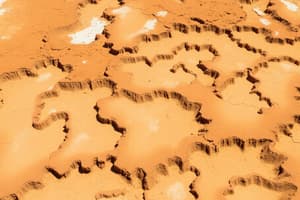Podcast
Questions and Answers
What is limestone?
What is limestone?
- A type of igneous rock
- A type of sedimentary rock formed from the remains of tiny sea animals (correct)
- A type of volcanic rock
- A type of metamorphic rock
What are ridges?
What are ridges?
Raised land that runs parallel to the coast.
What is a peninsula?
What is a peninsula?
A piece of land that is surrounded by water on three sides.
What role do rivers play in land formation?
What role do rivers play in land formation?
What types of landforms can be found in Florida?
What types of landforms can be found in Florida?
How are Florida lakes formed?
How are Florida lakes formed?
What is an example of a wetland in Florida?
What is an example of a wetland in Florida?
What factors cause the formation of Florida landforms?
What factors cause the formation of Florida landforms?
What are the landform regions of Florida?
What are the landform regions of Florida?
What consists of the Northern Highlands?
What consists of the Northern Highlands?
What are the Central Highlands made of?
What are the Central Highlands made of?
What do the Coastal Lowlands include?
What do the Coastal Lowlands include?
What shaped Florida's landscape?
What shaped Florida's landscape?
What defines hills?
What defines hills?
What is the largest lake in Florida?
What is the largest lake in Florida?
What shapes Florida's coastline?
What shapes Florida's coastline?
What do Florida beaches include?
What do Florida beaches include?
How are barrier reefs formed?
How are barrier reefs formed?
Flashcards are hidden until you start studying
Study Notes
Florida Landforms Overview
- Florida's land predominantly rests on limestone, a sedimentary rock formed from the remains of small marine animals.
- The state features ridges, which are raised lands marking ancient shorelines and run parallel to the coast.
Geographic Definitions
- A peninsula is land surrounded by water on three sides; Florida is a prominent example.
- Rivers play a critical role in shaping Florida's coastline by transporting and depositing sediment, contributing to the formation of beaches, barrier islands, and deltas.
Types of Florida Landforms
- Florida's diverse landforms include rivers, hills, ridges, coastal features, lakes, and wetlands.
- Lakes in Florida are often formed through erosion processes that dissolve the underlying limestone plateau.
- Wetlands, such as the Everglades, developed on a flat limestone block that tilts southward, facilitating water flow.
Landform Formation Factors
- Landforms in Florida are influenced by changing sea levels over time.
- Areas are categorized into distinct landform regions: Northern Highlands, Central Highlands, and Coastal Lowlands.
Characteristics of Landform Regions
- Northern Highlands consist of gently sloping plateaus.
- Central Highlands are composed of long ridges, contributing to the state's hilly terrain.
- Coastal Lowlands are characterized by dunes, extensive wetlands, and beaches along both the Atlantic and Gulf coasts.
Landscape Shaping Processes
- Florida's landscape has been shaped significantly by erosion and deposition processes.
- Hills in the state are naturally raised areas of land, with some in the Northern Highlands surpassing the height of traditional ridges in Florida.
Notable Features
- Lake Okeechobee is recognized as the largest lake in Florida.
- Coastal features like beaches are formed from materials including coral from offshore reefs and shell fragments.
- Waves and currents have further shaped Florida's coastline, resulting in bays, sandbars, and barrier islands, with barrier reefs forming offshore through coral colonies.
Studying That Suits You
Use AI to generate personalized quizzes and flashcards to suit your learning preferences.




